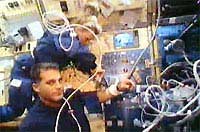With the special filtration system developed by Water Security, wastewater on spacecraft will be treated for reuse, including recycling astronauts’ urine into pure drinking water.
In the field of space exploration, providing water for astronauts in orbit is one of the most challenging calculations for scientists. Over the past five years, the National Aeronautics and Space Administration (NASA) has spent approximately 60 million USD to transport drinking water to the International Space Station via space shuttles (each gallon of water sent to space costs about 40,000 USD). However, this cost may be reduced thanks to a recent successful experiment. Scientists have discovered a more feasible method: recycling urine and wastewater from astronauts.
This is not a particularly unique initiative, but implementing it within the confined space of a spacecraft in zero gravity is not straightforward, and many people also wonder what it would taste like?
If the water reuse system is applied at the International Space Station, the amount of water needed to be transported to space could be reduced by two-thirds, freeing up enough space onboard for four additional astronauts.
Water Security, located in Reno, Nevada, USA, is a newly established company aimed at leveraging NASA’s technology for use on Earth. The company’s CEO, Ray Doane, eagerly showcases the mysterious box and states: “This is a groundbreaking technology”. Water Security has added a special filtration device to NASA’s system, creating a new filtration system capable of eliminating up to 99.9% of bacteria in water, resulting in completely purified water.
The Water Security filtration system consists of six steps, beginning with a basic filter that removes debris or large particles, such as hair or fibers present in the initial liquid. Next, a carbon filter eliminates organic waste substances found in urine, such as urea, uric acid, and creatinine, as well as disinfectants or bacterial agents commonly found in agricultural water sources. The liquid is then pumped through a system designed by Water Security that includes numerous synthetic iodine microparticles. Whenever microorganisms come into contact with these particles, they release iodine to destroy the microorganisms.
 Ken Kearney, the company’s vice president, states: “Iodine gradually dissolves into the water and remains very stable under a wide range of temperature and alkalinity conditions. This system can also address all types of heavily contaminated water sources on the planet and provide clean, safe water.” The water will be held for some time in a tank to allow iodine sufficient time to eliminate all microorganisms. Subsequently, a filtration system removes iodine, nitrate salts, and heavy metals. Finally, the water is passed through a filter designed to eliminate cryptosporidium (a type of waterborne parasite that is immune to iodine) and provide completely pure water.
Ken Kearney, the company’s vice president, states: “Iodine gradually dissolves into the water and remains very stable under a wide range of temperature and alkalinity conditions. This system can also address all types of heavily contaminated water sources on the planet and provide clean, safe water.” The water will be held for some time in a tank to allow iodine sufficient time to eliminate all microorganisms. Subsequently, a filtration system removes iodine, nitrate salts, and heavy metals. Finally, the water is passed through a filter designed to eliminate cryptosporidium (a type of waterborne parasite that is immune to iodine) and provide completely pure water.
For a long time, NASA engineers have contemplated the issue of human waste. The first 15-minute spacewalk by astronaut Alan Shepard was so brief that no one considered designing a urine containment system in the spacesuit. During this 15 minutes, an electrical malfunction occurred, delaying his return by 86 minutes. Shepard’s bladder quickly filled, and for the first time, he called back to mission control. After consideration, the control center replied: “Just let it go in the spacesuit”. Later, astronauts on the Gemini and Apollo spacecraft were equipped with a plastic bag that wrapped around their lower body. After filtering, the crew was instructed to seal the bag and mix it with a disinfectant liquid to create a “stable waste” as desired.
According to a NASA study in 1975, the Apollo waste management system relatively met technical needs. However, from the crew’s perspective, the system was entirely inadequate. For the space shuttles, NASA designed a toilet system costing 23 million USD that could dry waste for return to Earth.
Water Security’s filtration system allows NASA to address two problems simultaneously: it manages wastewater while recycling urine into drinking water for astronauts. NASA is currently testing this system at the Marshall Space Flight Center in Huntsville, Alabama. Additionally, Water Security has begun applying its technology in various areas lacking clean water supply.
This summer, the International Child Care Agency has established a water filtration system in northern Iraq. Robert and Roni Anderson, the agency’s founders, built this system on a specialized Toyota truck and brought it to dozens of villages to provide clean water. The system averages 5 gallons of water per minute, and in one day of filtering, it can supply enough water for a village of 5,000 residents to use for a month. The average cost is about 3 cents per gallon.
Not only war-torn areas lack water. After the tsunami struck Indonesia in December 2004, many clean water sources became contaminated with salt and toxins from the streets. Kearney noted that Water Security’s filtration system can also address such disasters. Overall, this technology has been tested in a wastewater area in Jakarta, producing water that meets environmental protection standards.




















































